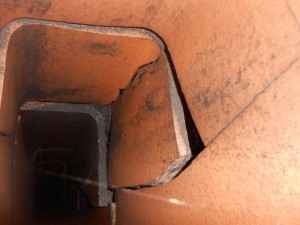You probably give little thought to your chimney’s interior, beyond your annual chimney sweep and inspection. However, your chimney liner should be a chief concern for your chimney maintenance. Making sure that your chimney liner remains free of cracks or deterioration helps keep your chimney performing at its best and eliminates a hazard for your home and family.
Functions of your chimney liner
 Your chimney’s liner serves as a protective barrier. It keeps smoke and heat from penetrating through the walls of your chimney and into the structure of your house. It also prevents the corrosive, acidic byproducts of your fires from penetrating and deteriorating your chimney’s masonry. A properly sized chimney liner also allows your fireplace or stove to draft properly, keeping smoke from flowing back into your home. Most importantly, in a chimney fire, your chimney’s liner contains the flames and heat that could mean major damage or injury to your home and family.
Your chimney’s liner serves as a protective barrier. It keeps smoke and heat from penetrating through the walls of your chimney and into the structure of your house. It also prevents the corrosive, acidic byproducts of your fires from penetrating and deteriorating your chimney’s masonry. A properly sized chimney liner also allows your fireplace or stove to draft properly, keeping smoke from flowing back into your home. Most importantly, in a chimney fire, your chimney’s liner contains the flames and heat that could mean major damage or injury to your home and family.
Types of chimney liners
Most new homes and some older homes are constructed with clay tiles to line the chimney. There also are stainless steel chimney liners, which are especially common with prefabricated chimneys or heating stoves. Chimney liners also can be poured into place in an existing chimney. People whose homes were built before the 1960s should be especially aware of their chimney’s interior: Some older homes were constructed without chimney liners, which is considered a safety hazard and can affect the performance of the newly installed furnace, wood stove vented into the existing chimney.
Chimney liner deterioration
Over time, chimney liners can break down. Clay tiles or poured chimney liners deteriorate due to weathering and are susceptible to cracks, particularly due to water penetration and high heat incidents. While metal liners are more durable, they, too, can corrode over time. Metal chimney liners break down quickly if the wrong type of metal is used for the fuel burned in the fireplace or stove. Your annual chimney sweeping and inspection is the best way to determine whether or not your chimney liner is in good condition.
Chimney liner repairs
If your chimney sweep finds cracks, gaps or overall deterioration in your chimney liner, you will want to have the liner repaired before you light another fire or use your furnace. Ignoring deterioration like cracks and gaps in your chimney liner allows heat to escape from your fireplace, or gases from your furnace appliance which poses a major hazard to you, your family and home. If your chimney liner is in need of repair, or if your chimney does not have a liner, there are several options for repair. A stainless steel chimney liner can be inserted into your chimney or HeatShield Cerfractory Flue Sealant can be applied to the chimney using a special form. The sealant is forced into the nooks and crannies of the chimney, created a new, smooth liner over the old failing liner.
If you’re concerned about the state of your chimney liner, call the certified chimney experts at Clean Sweep of Anne Arundel County. We can inspect your chimney liner with our Internal Digital Camera and help you determine the best fix if damage is found. Delaying chimney liner repairs impacts the performance,health and value of your home.
